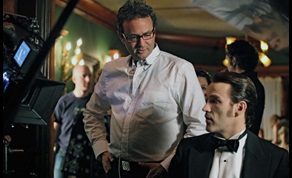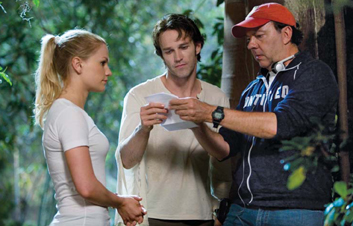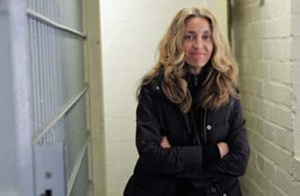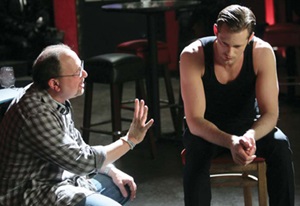BY STEVE POND
 THE UNDEAD: Michael Lehmann, who has directed the most episodes
THE UNDEAD: Michael Lehmann, who has directed the most episodes
of the series, works with one of the star vampire (Stephen Moyer).

Lesli Linka Glatter (center), with Brit Morgan (left) and Anna Paquin,
directed her first episode this season. (Credits: John P. Johnson/HBO
On a movie lot tucked away in a nondescript area of West Hollywood, the director of True Blood huddles with actor Alexander Skarsgård on the soundstage where a vampire bar called Fangtasia sits. At the same time, on an adjoining stage, the director of True Blood walks through a basement set with his production designer and AD, trying to decide if a set of shackles should hang from an overhead pipe or be secured to pillars. No, True Blood hasn't found the secret to putting a director in twoplaces at once. Instead, this is simply business as usual on the lot that's home to the HBO series about vampires, shape-shifters and other assorted denizens of the night who make their homes in a fictional little Louisiana town called Bon Temps.
"Every year, the show gets progressively more complicated," says the show's executive producer, Alan Ball, who directed the first season's pilot and fi nale episodes, but now delegates those duties to a relatively small group of directors. "You're doing what is essentially a 60-minute movie with a lot of special effects, action sequences and storyboarding. The only way to do it in our schedule is to overlap, to schedule three different episodes at one time to best utilize locations and actors."
For much of its November to July production schedule, True Blood, which began its third season in June, works on a couple of episodes simultaneously: one director will shoot with his team while a different director works on another stage. The show employs two first ADs and two DPs who alternate episodes. "You keep the same DP and AD on your episode, but this crew is so good the rest of the people are pretty interchangeable," says Michael Lehmann, whose eight episodes make him the most frequent True Blood director. "We share props and wardrobe, and with the script supervisors we try to make sure the actors are comfortable."
Today, Scott Winant, a veteran of seven episodes, is directing a barroom scene for the season's ninth episode, in which Skarsgård's vampire character, Eric, is interrogated by a severe, black-clad female vampire. Meanwhile, Lehmann is taking a tour of his sets before he starts shooting episode 10 tomorrow. "We're overlapping a lot," says Winant. "This last episode, I think I've only done three days that haven't been doubled up with another episode. Frankly, we've become dependent on the ADs' ability to schedule, and to make sure we're in the right place at the right time."
The director is talking as he takes his lunch break; while he and his crew are eating, the actors walk across the lot for the table read for Lehmann's episode. In addition to Lehmann and Winant, John Dahl and Daniel Minahan have also handled multiple episodes. This season, Lesli Linka Glatter and David Petrarca were hired to direct their first episodes; Ball says he expects to invite both back next season. So what does it take to be a good fit for the show? "I think you have to appreciate the sensibility," says Ball. "It's less about shots and more about characters. You have to be okay being efficient in a very laid-back atmosphere— people who need pressure and chaos don't really work here."
First assistant director Scott Schaeffer has his own perspective. "I would say that to be a good director on this show, you have to be a really good storyteller and to the point," he says. "Keep it simple—what we're doing is already complicated, so you don't need to overcomplicate it by getting overly visual. You have to be confident, you have to be a direct storyteller—and you have to be able to work nights." Certainly, the nighttime has always been the right time for True Blood. Created by Ball (American Beauty, Six Feet Under) from a series of books by Charlaine Harris, the series stars Anna Paquin as Sookie Stackhouse, a telepathic waitress who falls in love with a vampire. "I think Alan conceived the show as being satire on a fundamental level," says Lehmann. "The vampires are a metaphor for whatever societal outsider you want to slot in there: gays, or blacks, or liberals in the South."
 CHARACTER DRIVEN: Executive producer Alan Ball says directors need to be
CHARACTER DRIVEN: Executive producer Alan Ball says directors need to be
efficient in a laid-back atmosphere. (Credit: John P. Johnson/HBO)
But, he adds, that creates a diffi cult balance for a director. "Tonally, it's a challenge, because the show has to function as a bodice-ripping,overheated vampire romance story for all the people who like the guilty pleasure we get in that. But it also has to function as satire, or it won't distinguish itself from Twilight or The Vampire Diaries or whatever the hell else is out there. What's funny is that none of us are really interested in vampires," he laughs. Ball agrees. "I didn't want it to be vampires for the sake of vampires," he says. "I'm too old to be thinking, oh, cool, vampires!" Still, the vampire bar where Winant is shooting is a pretty cool joint. The set, all red and black, is spacious enough to accommodate cameras but cluttered with vampire ephemera: neon signs, bloodred T-shirts behind a merchandise counter, flyers stuck to the wall advertising phony bands like Tattooed Venus and Screams for Tina.
The scene is straightforward: Eric has run afoul of a higher vampire council, and he's being quizzed by a stern dominatrix type in black leather, who has set up a pair of webcams to transmit his testimony back to the bigwigs at the vampire headquarters called The Authority. Winant directs his crew to make a shot tighter. "I just love these faces," he says, looking at close-ups of Skarsgård and actress Jessica Tuck. When Tuck flubs one line on the second take, Winant, immediately asks for a quick playback of take one to see if she'd delivered the line correctly the fi rst time around. When he finds that she did, he smiles; it means he won't have to shoot another one.
Typically, Winant shoots two takes, prints them both and moves on. This scene will run throughout the episode—and while he's using straightforward angles to establish the setting, he plans to get more adventurous as it goes on. "When I come back to this, I might go more radical with the medium angles, maybe drop it to the floor," he tells DP Matt Jensen. "I won't have to repeat that big wide shot, because we'll know where we are."
The show often veers into grand, gothic territory, but for now the scene is wry and understated, played and shot straight. "What I really enjoy about the show is that it's not about making the stories fi t a style that's been established," says Winant. "So many TV series have a style that's intractable, where the look is the same every week. But Alan has respect for the traditional theatrical approach,which means we shoot every episode like a movie and make choices that support the narrative. Sometimes you're telling a story from a character's unconscious, sometimes you're doing something that's fantastic, sometimes you're grounded in reality."
Many of the choices are made at the beginning of each episode's production process, with a tone meeting that includes Ball, the episode's director, DP, and 1st AD, executive producer Gregg Fienberg, and the writer of the episode. "We go through each scene and talk about what the subtext is, what the tone of the performance should be, and sometimes how to shoot things," says Ball. That's followed by the production concept meeting, in which logistics are discussed.
"That's when we start talking about how we're going to do things," continues Ball. "'Okay, this vampire gets staked and explodes. How are we going to shoot this in a new way? Do we need to see it, if we've seen it before? We're using live wolves—how does that work?'" "Mostly, we're trying to fi gure out how to do it within our time frame and our budget," says Winant. "My ideas are a little bigger than time or money will allow, so I'm always looking for ways to make it work. And as the show gets bigger, we have to get more clever."
Glatter, who hadn't worked on the show before, says she found the meetings crucial. "One thing I loved is that they do the tone meeting on the first day," she says. "Usually on a series, people do it the day before you start shooting. But to do it on the first day, before you start preproduction, lets you in on everything you need to know so you can start planning how you're going to shoot. As a newbie, I really felt clued in from the first day."
As a newcomer to the show, Glatter also learned what all True Blood directors know: this world presents its unique challenges. "I don't know how many shows have people turning into animals, or animals turning into people," says Winant. "In my first episode this season, I went to Germany in 1943, I had dogs turning into birds and men flying, I had outrageous stunts.


 IN THE DARK: 1st AD Scott Schaeffer (top) and Sunday Stevens
IN THE DARK: 1st AD Scott Schaeffer (top) and Sunday Stevens
(center) keep it simple for the team. Scott Winant (bottom) working
on a scene with Alexander Skarsgard. (Credits: (top & center)
Doug Hyun/HBO; (bottom) John P. Johnson/HBO)
"The thing I like," he adds, "is that yes, there are computer effects, but generally we composite organic material. We don't generate anything exclusively through CG effects. We create physical effects, or we shoot plate work that is based on what we expose on the film, which is then digitally manipulated or composited. And that's what gives the show a seamless feel. If somebody is turning into a bird, it's a real bird, not a CG bird."
For Lehmann, one particular effects scene from this season was especially memorable. In it, vampire Bill (Stephen Moyer) is feuding with his maker, Lorena (Mariana Klaveno), who still desires him even though he's committed to Sookie. Furious, Bill throws Lorena on the bed and, says Lehmann, "is basically raping her"—but Lorena loves it, which angers Bill even more. "It frustrates him, so he takes her head and twists it 180 degrees so she's not facing him anymore," he says. "It's one of the more fun scenes I've ever had to shoot, because it's so twisted. But when I read it, I thought, how do I make it feel real? I wanted it to feel like you're just watching a scene of two people having sex—and then, oh my god, he turned her head around!" He explored various options with the show's effects team. "I said, 'How do I turn her head around and make it real? Do we take a dummy and transpose a living face on it? Do we put a twisted-neck piece on a real actress, and then put her face down attached to a body facing up? All of which we did."
True Blood's episodes have gotten bigger and more elaborate over its three seasons, and the production schedule and budget has grown as well—though all the directors say that even with more time and money, they don't have enough. Still, they're unanimous in their praise of a crew that knows how to do the work, and a network that more often than not gives them what they need.
For Winant, a crucial moment came late in the second season, when he had to shoot a scene in which Sookie watched a vampire willingly kill himself by standing on a rooftop at sunrise. "To the credit of the production, they did not want to do it as a CG effect," Winant says. "They wanted me to go 30 stories up and shoot a four-and-a-half page scene at dawn. Now, dawn doesn't last that long—30 to 45 minutes, maybe." Fienberg, the executive producer, worked out a schedule so Winant could take the entire cast and crew to a downtown Los Angeles rooftop days in advance, where they rehearsed the scene and blocked out every movement of the actors and cameras. "I marked every camera position, every alternate position, and every lens change on the roofof the building," he says. "And knowing that we were going to move fast, they allowed me to keep bold markson the fl oor that we would later remove optically."
When the shooting day arrived, the call was set for 2:30 a.m. "We had our positions worked out, we knew our shift moments, andwe shot the whole four pages, with lighting and special effects, in 40 minutes," he says. "And then that was matched to a reverse that was shot on a stage, because we had to create a fake sunrise. On most shows, if I pitched taking the entire company up to the top of a building and shooting in a 30-minute window, they'd turn me down. On this show, they insisted on it."
As True Blood's directors work on their individual challenges, they have to coordinate with other units and directors. Partly, that's because of the intricacies of the schedule. But it's also a function of the fact that every episode begins in the middle of the scene that had ended the previous episode, and ends in the middle of a scene that will begin the next one. Not only do different directors often shoot at the same time, they also share the same scenes.
"There is nothing autonomous about our episodes," says 1st AD Sunday Stevens. "You cannot sit there by yourself. It's not 'you and your episode,' it's 'all of us and the show.' So you end up going over to the other crew and say, 'When you shoot this scene, would it be okay if you left these gloves on the table? Because we're going to need them in our episode.'"
"In some of my episodes, I know that I'm setting up something elaborate for the next director to start with," says Lehmann. "One episode I did ended as one character burst in, threw another character against the wall and took a bite out of them. John Dahl was taking off right from that point, and he had a huge sequence to follow it. So I said, 'What do you need?,' He said, 'As long as you put this person on the right side of frame and this person on the left side, I'm fine.'"
Back at the lot, Lehmann examines the front porch of an old, decaying Southern mansion that's been sprayed with graffiti, and asks if they can add "more drips" to it. Winant, meanwhile, is inside the Fangtasia bar, watching the face-off between Skarsgård and Tuck.
When a little bit of background noise crops up near the end of one take, Stevens turns to Winant. "Should we go again?" she asks. Winant frowns; he has a lot more on today's schedule, and between the two takes he has got what he needs. "I can't afford to go too much more," he says. "We've got two more setups to do. I'm going to print that, and we're going to move forward." As the crew resets for the next shot, Winant leans back. "This is much more stimulating than catching the bad guys every week," he laughs. "On this show, I don't even know who the bad guys are."